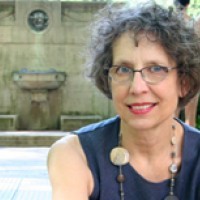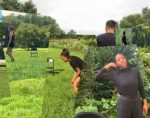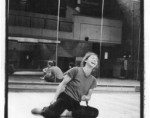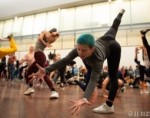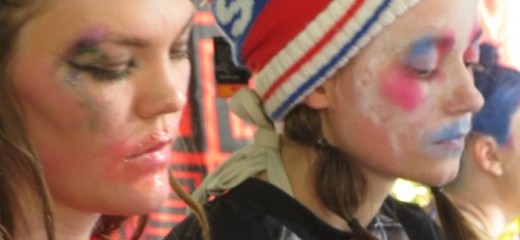
Photo: Lisa Kraus
APAP Diary – Gorging on Performance at Arts Presenters
by Lisa Kraus
In the wake of the Association of Performing Arts Presenters Conference (commonly referred to as APAP), there have been a slew of heavily critical assessments. Granted, the art marketplace aspect can be off-putting. Held each January in New York it runs “on the backs of” performers and choreographers. They are paid little if at all to show work. Writers as varied as
Claudia LaRocco,
Andy Horwitz and
Alastair Macaulay found the dance on view to be indulgent, underdeveloped, uninteresting. Pushback came from performers and organizers on Facebook and in comment threads on these articles.
One charged subtheme this year was about bullying within the scene itself as Ann Liv Young as her alterego Sherry terrorized and /or effectively critiqued Rebecca Patek (depending on whose version you subscribe to) during the latter’s show. Siobhan Burke on that
here.
All this makes my intense experience as an out-of-towner and the resulting comparatively benign assessment seem tame. So be it. I am grateful to be in such a concentration of dance activity. As a presenter, the ability to spend most of every day looking at and listening to live art is precious and efficient. So what follows is a blow by blow, both personal and professional, of the most jam-packed period of my, and many others’, year.
Day 1
Made it out the door late for the train and with the detour in Hamilton had to get a later one. That meant no time in NY to check the bag at the hotel and get registered at the Hilton but instead going directly to New York Live Arts, down 8th Ave. in a soft drizzle, what they call “moth rain” in Holland.
In the studio, sat next to Jaamil Kosoko who filled me in about Miami. The Facebook photos of him there at Art Basel were so goofy, with a shock of fuzzy hair like a pompadour in front, like a black Lucille Ball. He said it wasn’t his scene. People making megabuck deals around visual art. Of course with performance happening so much in museums these days, you might think it would be productive for him as a young presenter/maker. He said the parties were good.
Donna Uchizono’s Fire Underground struck me as a piece that had to be made. As articulate as speech, it is her way to communicate about the traumatic experience of the 12-year process of adopting and bringing her Nepalese daughter to the U.S. The work evokes the aching longing of two people caught in a strange and perplexing limbo.
The costume for the daughter figure in the first section was split down its long skirt in the back, revealing her buttocks. I had just read about toilet training in China (on Facebook, natch) and that’s the method. So this bespoke vulnerability, infancy.
The dance features recurring play maneuvering weighted balls on chains and spinning in sufi-like long skirts. And proximity and distance. I had the image that for Uchizono this work is her spinning straw into gold; she spins the substance of her history into movement.
Beth Gill’s new piece will likely be a catalyst for big conversations around appropriation and the boundaries of authorship. It reflects her interest in Trisha Brown’s Newark. There were many former Trisha Brown Dance Company (TBDC) dancers there, including two who had originated roles in that dance. What Gill borrowed: shapes, structural devices, a tone, specific actions. Hers looks like a remake of something recalled from memory.
No one I spoke to had an easy relationship to what they’d seen and many questions arose: Is this homage? Where is the boundary, as in music, between “sampling” and full out plagiarism? What does it mean when one artist goes to another for inspiration and uses what they see in a way that’s quite direct? Do they have a responsibility to fill us in specifically on what the relationship and thinking is relative to the original? On what the process is?
I saw many beautiful arrangements of the original’s juxtapostion of rooted, slower-moving “men’s material” versus the Brownienne motion (which is utterly unmistakable) of the ladies. Gender doesn’t remain the distinguishing factor in Gill’s dance, but Trisha was consciously exploring maleness and the capacity of male bodies in this dance.
It’s also provocative how Gill appropriated from John Jasperse. Moves from his Fort Blossom were unmistakable. In it he contrasted male/female quite clearly.
Lots of interesting discussion will be swirling around this work for sure.
Caught up with
Craig Peterson and a huddle of us spoke about being parents, and real estate. With
Laura Faure and
Meredith Lyons of Bates College we talked about documentation and writing as practiced there and the unique experiments
Marlon Barrios Solanos conducted last summer fashioning an online interactive learning community, the
Meta-Academy.
Finally Cynthia Hopkins, someone on my radar a long time but I’d never managed to see. Her work is soul-baring, tender hearted, sly. Great songs, great morphing from one character to another, great buffoonery.
Meeting with Susan Rosenberg, scholar-in-residence of TBDC talking archive in the body, the compelling work of Babette Mangolte (photographer/filmmaker), how you talk about collaborations, the sadness that so many of Trisha’s great collaborators are no longer alive. Susan headed the next day to Marfa to view Donald Judd’s papers around his work with Trisha.
Then at the Public Theater for Under the Radar (hopped into a cab, time too tight otherwise) was not able to get into The Record. If I procrastinate and don’t get tickets before even heading to NY because I’m unsure how best to use the precious time there with so many options, I’m sometimes shut out. This piece had gotten a fabulous review in the Times that very day.
 Public Theater Lobby
Public Theater Lobby
Anyway, Irene Hultman was in the same boat so we sat and talked about her teaching at Yale, artists she is working with, a plan for the Park Avenue Armory. Our shared interest in promoting the work of people we’re excited about.
So many substantial conversations in one evening. Definitely hooking into my tribe.
Sheraton Hotel is familiar now after all these years. Comfy big bed. Glad I brought my own tea.
Day 2
Agents agents agents. They, and sometimes artists representing themselves, spend oodles of money to have a booth and prepare the materials they need to sell their wares in the exhibition halls. There are three halls, each set up like a village of streets with booths on either side. People have big graphics and often iPads or monitors with performances playing. They beckon you in, to buy, as at any street market.
 Peking Opera performer doing her make-up in the exhibition hall
Peking Opera performer doing her make-up in the exhibition hall
This is my eighth APAP as a presenter so I know a lot of people. Presenting at Bryn Mawr College, which encompasses music and theater as well as dance, is like preparing a different kind of banquet each year. Because of APAP I have largely learned who has the excellent mushrooms, who to get fish from. But of course there are always surprises. Finding them includes wandering through the exhibition halls.
To do that you need to purchase both APAP membership based on the budget of your organization and registration to the conference. Pricey.This time I signed up for just one official conference day, saving a neat $400. But that meant swooping swiftly through these rooms. Being less versed in music than dance and theater, this is where it’s especially useful. You see who’s on whose roster, pick up CD’s or flash drives for listening or looking later, speak with agents about your parameters and, when they represent interesting folks, make plans to speak with them after the conference.
 APAP attendees coming, going and networking
APAP attendees coming, going and networking
With the agents who represent excellent dance, like Rena Shagan or Pam Green or the Pentacle people or MAPP you reconnect with them so that when you’re on the phone you can all put faces to names and your business proceeds in a more personalized way.
Some agents are incredibly skilled at understanding what it is you do and look for. You often book times to have individual talks not by chance but by design. The conversation with them is really a problem-solving situation. How can the artists they represent fill a need you have? They often get you to stretch in one way or another. They are tough but agile.
The art marketplace aspect is distressing to many. Especially the showcase part. Artists know that whatever is being performed there is in direct competition with many, many other things. The booklet listing showcases is about the size of a bible. And many artists feel they don’t get much in the way of tangible results from putting out.
Still, 45,000 people come to NY in January for the concentrated dose of culture possible with all the festivals (Coil, American Realness, Under the Radar, Focus Dance, Live Artery plus showcases ). And lots of deals get made.
~ ~ ~ ~ ~ ~ ~
APAP's a three ring circus with three kinds of engagement happening simultaneously. That’s what makes it so challenging. The first two are what I’ve been describing—the exhibition halls, which are open generally about six hours a day, and the showcases and performances within the festivals. The third aspect is the official program of consortia, professional development sessions, consultations, workshops and plenaries.
 Pecha Kucha speakers included Wendy Whelan and Kyle Abraham
Pecha Kucha speakers included Wendy Whelan and Kyle Abraham
Some things I learned in those kinds of sessions today: presenters are shifting how they see their performing arts venues toward much more participatory models. Hacking sessions, mini makers fairs are eliciting creativity. Watchers connect with puppetry in a special way because we project emotions onto puppets, often creating a stronger bond than with a live performer. Etc.
More catching up with colleagues. Laurel Tentinido filled me in on her experience so far of the UCLA MFA.
Elena Demyanyenko and Dai Jan’s work is, to me, a tonic. It inhabits a place where the great physical skill of Trisha’s ex-dancers can be channeled into something highly personal, human, less heroic and abstracted and more strange and shifting. But still exquisite. Very intimate, very clear and fresh and uninsistent.
Tere O’Connor’s Bleed at Danspace was operatic. 11 performers, with movement really tailored to their own dancing qualities (I think especially of Cynthia Oliver here). And Danspace was packed.
Day 3
There comes a moment at APAP when you know you’ve hit max input but you just keep gorging. I hit it yesterday when I realized that I probably could not articulate clearly what I learned in the several useful sessions on building connections with audience—the first about students and the second more generally in community. Lots of initiatives and things to add to the “to do” list at Bryn Mawr. Anyway, resources with this info are online.
That feeling of overfull doesn’t interfere with appreciating what’s moving or skillful or fun. It just prevents feeling like you could possibly digest it at the moment. Everything settles once back in PA.
In the evening, I saw Sekou Sundiata’s Blessing the Boats: a remix , a moving Under the Radar presentation of a former solo, about Sundiata's struggle with kidney disease, the hard living that brought it on and the compassion or lack thereof of people in his world. Now fashioned into a trio, and spectacular.
In the afternoon, Marten Spangberg filled the dome at MoMA PS 1 with slo-mo partying young folks creating cocktails of goo and smearing each other with paint in a psychedelic series of ripoffs from other choreographers, poses, clothing changes and references to worlds of glamor, decadence and interactive joy. Great pulsing music. An immersive, tripped out extravaganza.
Spangberg's opus

Tina Satter’s play about a small dance studio where one aspiring young thing wants to enter a big time competition. So interesting to see Wooster Group-style timing and pregnant pauses and caricature mixed with this subject matter. Made for great disjunctive dialogue and weird narrative jumps and scenes. Definitely a particular taste. But fun.
And then in the Abrons Art Center lobby at the pop-up bookshop for American Realness, buying ALL the Danspace platform catalogs to catch up after browsing a long while and reading a correspondence between Miguel Gutierrez and Steve Paxton which feeds into thinking about a project I’m developing now.
That dialogue fed into my talk with curator/writer/artist Marissa Perel at the diner after we took in about two and a half hours of the four and a half hour Spangberg show (apologies, but we needed some time to talk). Because that relationship of seminal older artist to younger generation definitely figured in, again with questions about what do you do with what others have found or created…What’s relevant, what’s worth re-examining or lifting and how do you do it?
The in-betweens—New York in the sunshine, hipsters at PS1, homeless folk and great musicians in the subways, chance meetings and millions of strangers—well, there’s nothing like that.
 Waiting outside the dome to see Spangberg's show. Facing camera Amamda Miller of Miller-Rothlein
Waiting outside the dome to see Spangberg's show. Facing camera Amamda Miller of Miller-Rothlein

Day 4
Took the New Jersey Transit train back and arrived home at 2:30am. Things are so quiet here compared to the everywhere-something-to-see of NY.
Thinking backward, the APAP jaunt ended with a tour de force solo of oration by Valentijn Dhaenens from Belgium who juxtaposed words of Goebbels and Patton (exhorting a public/soldiers to war and victory), Socrates, MLK, most on themes of violence and oppression and mercy. Great staging using a long table and multiple mike set ups allowing him to shift position and voice to indicate his transition to becoming a new speaker. Ingenious projection of the names of the original orators on a chalkboard. As their speech has passed the name is erased so we easily follow whose the voice is. But most stunning is Dhaenens’s shapeshifting. A consummate young actor.
Down on Ludlow Street in a loft/home/performance space Tongues in Trees offered whisky and snacks. We sat on leather couches to hear the trio’s hard-to-categorize mix of jazzy Indian-inflected new music. The singer Samita Sinha is represented by MAPP productions and you see both a self-consciousness of her beauty and an edging toward finding a new way of using voice to express something about her nationality (Indian) and womanhood. One song was based on traditional lyrics of Tagore about resisting oppression. I knew because when a bunch of the Indian folk in the audience clapped and were clearly roused, I asked my neighbor to translate.
 The scene on Ludlow Street
The scene on Ludlow Street
The show The Record in Under the Radar came highly recommended by several dance friends and got a whopping endorsement from the NYTimes. It had been sold out but I called back repeatedly and was able to get a ticket the day before at the box office (I guess presenters give tickets back that they won’t use). Very glad. The set-up is super-simple: a big black box space with a sizable wooden square on the floor and a square sheet of sailcloth arced directly above for a kind of protected and somewhat glowing playing area. People in what look like their own clothing enter, face different ways but mostly toward us, take shapes, echo each other’s actions, make clusters and basically through largely pedestrian action tell a story about being in community, being human, and end of life. Great cello and electronics played live. Forty five people all ages, sizes, colors. No speech. And what’s remarkable is how the directors (600 Highwaymen) have elicited performances that are humanistic--not self-conscious, not arrogant, not cool, not any of the things that so many performances where the performer looks out at the audience are. Many of the performers seem to be smiling inwardly. When they look at us they neither take anything nor give anything. Maybe they are just “inviting being seen” as in Deborah Hay’s parlance. But the effect is one of openness, vulnerability, tenderness, warmth. We feel that these are people we share the planet with at this time, this oh-so-temporary time. The people in the audience likewise are our companions. It’s a pretty amazing thing for a performance to do, and a wordless one at that.
David Byrne was in the audience and I couldn’t help think about what he might be thinking—that this evolution back into a totally stripped down kind of performance (who knows, they could easily have been influenced by Trisha Brown’s Line Up –I saw what looked like one section from that dance lifted and transposed—or Steve Paxton’s Satisfyin Lover which appeared at MoMA last year) is a logical evolution from his own madcap geeky performing.
Sometimes you wonder what draws you in a particular direction. I generally try to see things I haven’t seen before when at APAP but when I read that Soledad Barrio was giving a showcase, despite the fact that I knew what she is about, I wanted very much to be there. For myself. She is one of the burning bright artists of our time. So imagine my complete astonishment that after a smoldering solo of hers (how did she go from zero, waiting outside the space with the spectators until 3 minutes before they began, to sixty in one second?) there was a sneak peak at an in-progress collaboration with the director Lee Breuer of Mabou Mines of whom I’m a huge fan. Antigone with Barrio as Antigone. She so gets tragedy. I began weeping within about two seconds. Such depth of feeling. Kun Yang Lin was there too and said that she should work with the Graham company. There was something really Graham-esque in the shapes they were making…an excellent fusion of forms.
My last conversation with a booking agent was with Robert Besen who represents a good number of classical music artists. We always have substantial talks and this time I was sharing what came up the day before in the panel about arts attendance by students and what was said about creating buy-in for classical music. He and I talked about the mixing of one of his groups with a college ensemble, like a string quartet with the college chorale, as one way to create further interest.
The panel this idea sprang from was asking college presenters to commit themselves to the effort to help grow future performing arts audiences not necessarily for the immediate reward of having increased attendance in the short term, but by creating events that will foster continuing involvement in the arts down the line. The value of live performance needs to be argued for in the era of instant downloads and endless on demand video and music. All right. That’s ultimately what the APAP feast is all about—connecting artists and audiences.
~ ~ ~ ~ ~
Author's Note--Choosing showcases to attend was informed primarily by whether the work might be a good fit for Bryn Mawr College (re: budget, logistics, aesthetics). Secondary was witnessing some unfamiliar artists or developments in the field.
All photographs by Lisa Kraus. They were taken in select shows where doing so would not disturb the audience.
By Lisa Kraus
January 30, 2014














